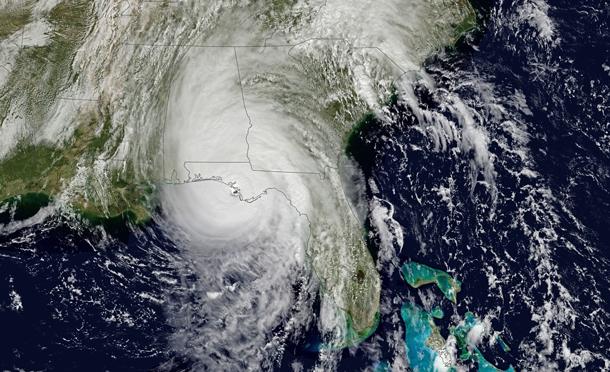Warm waters in the Gulf of Mexico raise alarm as US storm season approaches
As storm season begins in the southeastern US, scientists are casting a wary eye on the warm waters in the Gulf of Mexico.
Science links above-average sea surface temperatures in the Gulf of Mexico to larger tornado clusters and supercharged hurricanes in the southern and southeastern United States. The tornadoes that hit the southeastern US on Easter Sunday, resulting in over 30 deaths, came as water in the Gulf of Mexico was running three degrees Fahrenheit hotter than the long-term average.
Tornado season in the US generally runs from March through June and hurricane season follows right on its heels. Warm waters in the Gulf provide “a basic fuel” to these massive storms, explains atmospheric scientist Kevin Trenberth, a distinguished scholar at the US National Center for Atmospheric Research and a faculty affiliate with the University of Auckland in New Zealand.
Related: Warming ocean waters turned Hurricane Michael into a superstorm
“Warm, moist air wants to rise, and as it rises, the moisture condenses [and] creates extra heating — we call it latent heating — in the atmosphere,” Trenberth says. “All of this convection in the atmosphere moves heat from lower levels into the upper part of the atmosphere and then it gets transported by the jet stream and the circulation to other parts of the world. Some of it can actually radiate to space. [Storms are] one way the atmosphere responds.”
Different types of atmospheric disturbances tap into this heat, but essentially “they’re all trying to move the heat away, in some sense,” Trenberth explains. “It depends quite a bit on the nature of the disturbances — whether there are a lot of, say, individual thunderstorms, or whether there are these larger supercell complexes that can indeed trigger major tornado outbreaks.”
In 2017, similarly warm waters in the Gulf of Mexico led to disastrous consequences, as Hurricanes Harvey, Irma and Maria all caused massive destruction. In 2018, one of the hotspots in the global ocean was off the east coast of the Carolinas, Trenberth notes. Hurricane Florence developed in this area, producing 30-40 inches of rain and catastrophic flooding.
Related: Scientists pinpoint link between climate change and Hurricane Harvey’s record rainfall
A lot can happen between now and the start of hurricane season to change the current conditions in the Gulf, but if storms moving toward the US encounter the right environment, they could again become exceedingly dangerous.
Trenberth says the lack of preparedness for the novel coronavirus that he is seeing in the US and around the world is “really dismaying,” and has a parallel in the realm of storm preparedness.
“The big warning sign was in 2005, with Katrina, Wilma and Rita. … The concern was certainly there. What has been disappointing, from my standpoint, is how little preparedness seems to have developed.”
“The big warning sign was in 2005, with Katrina, Wilma and Rita — all these Category 5 storms that occurred then,” he says. “I went to some meetings, which had heads of states of some of the islands in the Caribbean and the Gulf of Mexico…and, correctly, they were very concerned about two things: the rise in sea level, and stronger hurricanes. So, the concern was certainly there. What has been disappointing, from my standpoint, is how little preparedness seems to have developed.”
Hurricane Harvey in 2017 highlighted this problem, Trenberth points out: “The total lack of adequate drainage systems, building in wrong places and building structures that weren’t prepared in Southern Texas,” he says. “The lack of preparedness in Puerto Rico was astounding, appalling. … The warnings have been there. Why isn’t there more effort to prepare for the sort of thing scientists have more or less guaranteed, but can’t say exactly when?”
This is the paradigm for global warming, Trenberth warns. Global warming is coming, but there is one crucial difference between global warming and a deadly virus like COVID-19. Unlike a virus, for which we can ultimately develop a vaccine, “once global warming is here with us, no vaccine is going to be developed that will make it go away.”
“So, I think this is a warning sign,” Trenberth says, “and I certainly hope the governments around the world and the peoples around the world can take account of that.”
This article is based on an interview by Steve Curwood that aired on Living on Earth from PRX.
